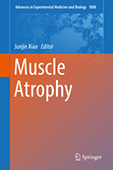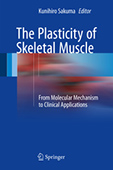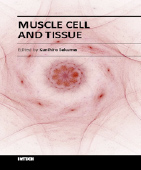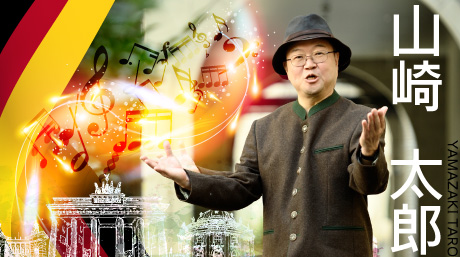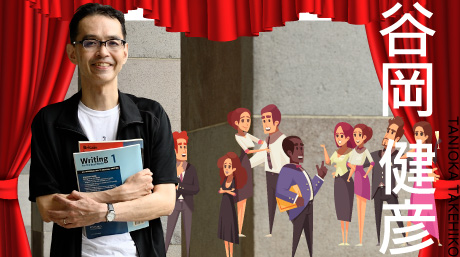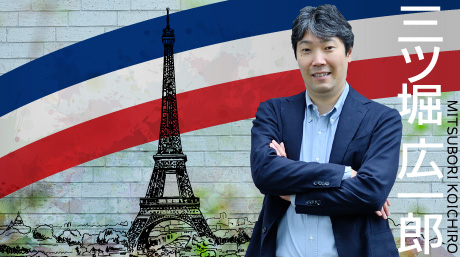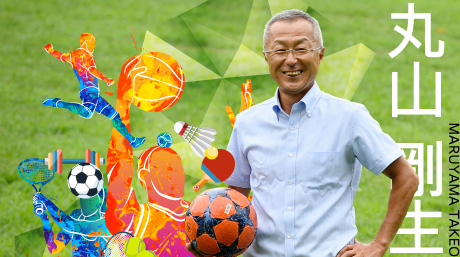Institute for Liberal Arts News
Learning about Muscle and the Importance of Exercise Makes a Difference in Life
Professor Kunihiro Sakuma, Exercise Biochemistry, Exercise Physiology
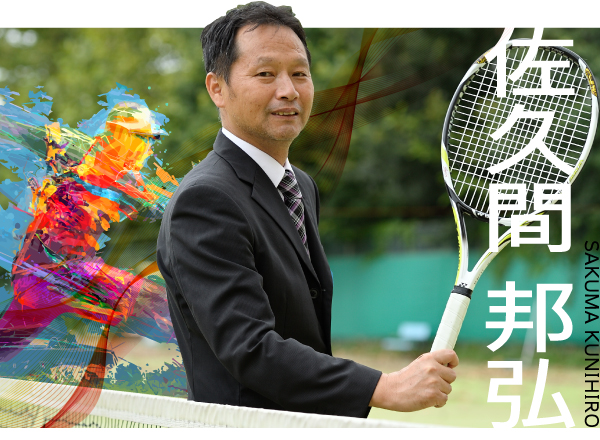
Muscle lecture and tennis skill training courses
I’m in charge of two types of courses: lectures held inside the classroom and exercise classes in tennis courts. The first is a muscle lecture course for graduate school students, and the second is a wellness course for undergraduates.
The lecture course for graduate students is entitled “Graduate Lecture in Education, Welfare and Health F1,” and it shows the mechanism of how muscles change by aging and how we can reduce such muscular deterioration. It also covers topics such as iPS cell development in Japan and facts about functional foods, or so-called “health-conscious foods.” in charge of two types of courses: lectures held inside the classroom and exercise classes in tennis courts. The first is a muscle lecture course for graduate school students, and the second is a wellness course for undergraduates.
Though categorized as a lecture, the course is based on group work. It starts with a specific topic I give. Each group researches the assignment and then reports the result in the classroom, where I add a detailed explanation or follow-up. I started to use this style when I joined Tokyo Tech, and I found it quite useful. With an emphasis on students’ voluntary learning instead of being taught, it can engage them in thorough research and deep thinking as well as effective presentation. Besides, as physical conditions, health, and food issues can be their own concerns, learning becomes part of their lives—something hardly achieved through ordinary lecture sessions.
In my tennis training course (a wellness program), students are split into several levels according to their tennis skills; then, they engage in matches with other players of the same level. But, the rule of the game is, “Losers of games must go through a push-up session without exception.” Please be relieved, however—a push-up here is not “punishment,” but it’s an exercise (laugh).
Winning games is crucial, even if they are just part of the class. When you have lost a game, don’t dismiss it by thinking that it’s just a play. Instead, I want you to face it as the result of a serious game. Observing how students play, I have the impression that they lack the experience of fighting hard under specific rules to win. They are not attached to the victory. As they are content in other areas, they are not hungry for achievements in sports. Or, for them, a game may be something that they can retry with a push of the reset button. However, winning is essential for sports activities (such as tennis). Persistently fighting to the last, and seriously studying how to win, or how to cooperate to win in doubles, hold significant meaning in playing sports.
Research on the mechanism of muscle deterioration with aging

I started playing tennis at seven. As my father was a teacher and a tennis instructor at a high school, playing tennis was a natural course for me. Manga works such as Ēsu o nerae! (Aim for the ace!) and Tenisu bōi (Tennis boy) were popular at that time. Significantly improving my skills in my teens, I won the regional junior championship more than ten times. But advancing through national tournaments was something I never overcame, and my best record was to win the first match.
However, my passion for tennis never waned. Even if I couldn’t beat national champions, I still wanted to play among them, on the same court. So, I decided to enter a university with a strong tennis club near Tokyo, but I was not thinking of choosing a sports-related school. I planned to study mathematics, my strong suit, influenced again by my parents, who both were math teachers. Then, my chemistry teacher recommended to me an unexpected choice, saying that it might be the best university for me, and that was the School of Physical Education, Health & Sport Sciences of the University of Tsukuba. After visiting the university for a campus tour, I was sure that I wanted to learn there. Only less than two months remained until the National Center Test; changing the target at that point was risky and challenging, but I took a chance, and fortunately, was able to pass the exam and enroll in the university. Of course, I continued playing tennis there.
But my tennis performance at university was not outstanding due to an injury I had. Therefore, in my third undergraduate year, I decided to focus my energy on research and devoted myself to studying the mechanism of muscle fiber composition conversion at the lab of Professor Shigeru Katsuta, one of the most prestigious researchers in the exercise physiology and sports science fields in Japan (His lab attracts elite students from other universities and therefore, the competition to join was among the highest). The field of my research is interdisciplinary, involving medicine, physiology, and pharmacology.
My current research focuses on sarcopenia, a mechanism of muscle loss or deterioration caused by aging, as a member of the Japanese Association on Sarcopenia and Frailty, an organization devoted to studying muscle deterioration with aging. Because of the cross-disciplinary nature of the research, the association consists of 70% medical doctors and 30% researchers in fundamental science fields like me.
Muscle deterioration is due to dysfunctional mitochondria and denatured proteins remaining in the muscle cells over time. Normally, those unnecessary components are removed by the process called “autophagy” (a mechanism to decompose proteins within cells), but, with aging, the function gradually loses its effectiveness, leaving unwanted remnants. These leftovers disturb the normal protein and mitochondrion activities, leading to muscular loss. The question is this: Is there any way to prevent this? A finding made in recent years says that eating moderately or practicing exercise is crucial for the elderly (except those who are undernourished). My current study focuses on unraveling why autophagy stops functioning normally due to aging and its detailed mechanism. I hope my research can help clarify the causes of muscle deterioration and discover effective counter-aging measures.
Sometimes it’s important to jump in
instead of mulling over the result
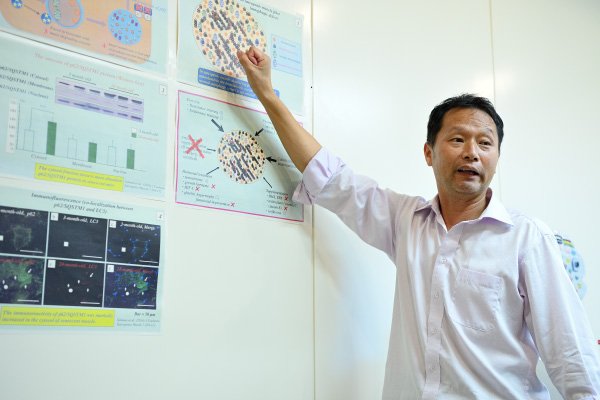
I’m part of the teacher team at the Institute for Liberal Arts, which supports 1st-year undergraduate and graduate students through the Tokyo Tech Visionary Project and Leadership Workshop, respectively. These projects both feature group works as they are specified as part of the Core Liberal Arts Education, and therefore, part of the required curriculum. Unlike lecture-type classes, the owners of group work sessions are the students themselves. In that sense, teachers are required to properly steer their activities behind the scenes. For example, group work will be spoiled even if only one member keeps showing indifference or disrespect to the assignment or never stops chatting. But teachers cannot use authority to control them because it would take away their initiative.
Therefore, my method is to use timely interruptions to get their attention or give some advice or encouragement while letting them proceed with their group work for most of the duration. I try to do this carefully by choosing when. Strangely, my tennis club experience back in my school days helps me in my role.
For example, due to my long-time experience as a tennis player and trainer, I’m good at discerning the condition of the team through individual members’ behavior or eye movements. I know how to speak loudly so that my voice will reach everyone playing tennis outdoors. I can sense, even from a distance, that something unfavorable is about to happen, so I can immediately go for support. Such risk management is easy, thanks to my tennis career.
The Leadership Workshop is a program for graduate students, starting in April. During the workshop, there is an interesting session called “Classmate Introduction.” Each member is required to write the introduction of their classmates with whom they’ve just gotten acquainted and read it in front of the others. Unlike self-introduction, you cannot usually introduce someone you’ve just met. That’s why you can use this session to train your communication skills. You should listen to that person carefully so that you can understand them and learn about their attractiveness.
Another notable session is “Something in the Past I’m Ashamed of,” where you share something in the past which you feel ashamed of with your newly-met classmates. It takes enormous courage to do so, and, in that sense, you can prepare yourself to stop being shy and jump in
In the first year of testing those sessions, we (teachers) were not sure if the hurdle was too high for many shy Tokyo Tech students, but, on the contrary, they all were having fun while seriously sharing their stories of failures.
We could bring the good qualities out of Tokyo Tech students who are shy but diligent and open-minded. It was a success considering that it could pull new students from their psychological shells.
In Japan, many excellent students tend to hesitate to dive into something they are not sure of its significance for doing. It takes a bold action to plunge into a new environment. But once you are in, probably against expectation, people will embrace you and show their hands. If there’s just one thing that I want to share with 1st-year students, it is the courage to dive into something new.
By the way, Tokyo Tech classes use a tool called the “Reflection Sheet.” It functions not only as an attendance sheet with the student’s ID and name but also as a summary note where they can look back and fill in what they’ve learned in the class.
I didn’t use this sheet during the first year of implementation, but I began to use it in the second year. I found that it was a beneficial education method. It serves as a two-way communication vehicle by adding the teacher’s comments or highlighting essential parts of the student’s summary.
Make regular exercise part of your daily life

Recent studies show that exercise is the only sure way that works for preventing Alzheimer’s disease. Most preventive measures considered so far, including medicine and certain food, have proven insufficient in terms of effect. Research on depression has also verified the effectiveness of sports activities. As a researcher of muscular loss, I would say the same; despite other methods that may work to some extent, the most effective form of prevention is exercise, which is, therefore, absolutely necessary.
Let’s see how exercise benefits our body. Muscle movement releases at least thirty kinds of myokines intercellular modulators into the blood. Those myokines repel colorectal cancer-causing cells and work in favor of our brain and internal organs. There is even a finding that can challenge the traditionally-held idea that muscles were always subordinate to the cerebrum. In other words, the cerebrum commands muscles to move the body to engage in exercise. Contrary to that, however, the recent discovery says that moving muscles first (instead of the cerebrum) often can trigger a positive impact on our mind and body.
By considering those recent studies, it’s essential to maintain sound and healthy muscles, in addition to developing intellectual abilities. That’s how you can enhance the quality of your life. Therefore, make regular exercise part of your daily routine to foster your muscle power. By doing so, you can match your physical strength to the level of the intellectual prowess you already have as an excellent Tokyo Tech student. Maintaining a sound body and mind will surely benefit your academic achievements. Now, why don’t you start enjoying your favorite sport to reinforce your muscle movement?
![]()
Professor Kunihiro Sakuma
Research Fields: Exercise Biochemistry, Exercise Physiology
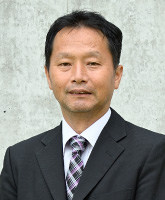
Graduated from the School of Physical Education, Health and Sport Sciences at the University of Tsukuba (Exercise Physiology) in 1991. Obtained his doctorate (Physical Education) at the Graduate School of Physical Education, University of Tsukuba. Served as a researcher of physiology at the Aichi Human Service Center, Institute for Developmental Research as an assistant researcher and a lecturer at Department of Forensics Medicine , Kyoto Prefectural University of Medicine, and as an associate professor at the Physical Education and Health Center at Toyohashi University of Technology. A member of the Japan Society on Sarcopenia and Frail (Director) and the Japanese Society of Physical Fitness and Sports Medicine (Councilor).
